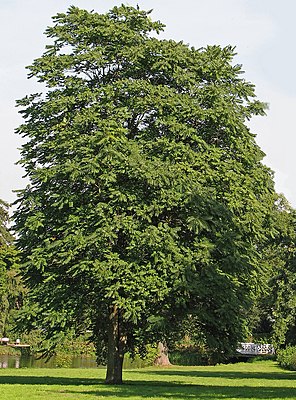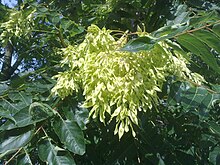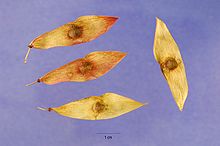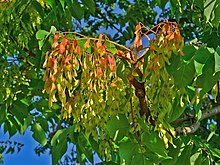Tree of gods
| Tree of gods | ||||||||||||
|---|---|---|---|---|---|---|---|---|---|---|---|---|

Tree of Gods ( Ailanthus altissima ) |
||||||||||||
| Systematics | ||||||||||||
|
||||||||||||
| Scientific name | ||||||||||||
| Ailanthus altissima | ||||||||||||
| ( Mill. ) Swingle |
The tree of the gods ( Ailanthus altissima ) is a deciduous tree - species of the genus Ailanthus from the bitter ash family (Simaroubaceae).
distribution
The tree of the gods is originally native to China and northern Vietnam . Since the mid-18th century, the species has been planted in other parts of Asia, as well as in Europe, America, and later in Africa and Australia, where it is considered an invasive species . As a result, the tree of the gods spread, meanwhile it is represented growing wildly worldwide in all areas with a temperate or Mediterranean climate .
Botanical description
Growth habit, age and height
The tree of the gods is a medium-sized, deciduous tree (life form phanerophyte ) with a richly branched and round crown, which in Central Europe can be 27 to 30 m or more high in good locations. In the Mediterranean area and in nutrient-poor, dry locations, it usually only reaches heights of 18 to 20 m.
As a pioneer tree , it usually does not reach 100 years, although much older trees are known. The oldest in Germany grew in a garden of the Arminius pharmacy in Bad Lippspringe at Detmolder Straße 163. The tree reached a trunk circumference of 1.40 m, a height of 35 m and an age of 150 years.
The tree of the gods is considered to be the fastest growing tree in Europe. The greatest increase in height occurs in trees that are 5 to 10 years old. After 20 years the increase in height slows noticeably. In favorable locations, seedlings can reach a height of 1–2 m in the year they germinate . In good locations, 20-year-old trees can be over 20 m high. The height growth is particularly strong in sprouts that are vegetatively driven out of the root ( root shoots ), or in stick rash that occurs after a disturbance of the trunk, e.g. B. as a result of combats, forms numerous. Such rungs can grow up to 3 m long in a year.
Branches, trunk and crown structure
Young shoots with leaves are greenish and have short hairs. Older branches are reddish or brownish and hairless. The trunk is relatively smooth, has a gray-brown and sometimes slightly cracked to slightly furrowed bark , which sometimes has a diamond-shaped pattern.
The growth of the shoot is not continued by the terminal bud , but by the side buds below. This sympodial growth leads to an irregular crown structure. A change in the branching pattern after about 10-15 years is typical of the tree of gods. Then the further growth is taken over by one or two now leading side shoots ( monochasic or dichasic growth).
leaves
The large, alternate and unpaired, stalked leaflets are often 40 to 90 centimeters long. They can be over a meter long, especially on young root shoots or stem rashes. The largest known leaf had a length of 1.67 m (Kowarik & Säumel 2007). The rachis and the leaf stalks are greenish to reddish in color and almost bare. A stalked foliage leaf is made up of 20–30 (maximum 43) elongated egg-shaped to lanceolate, whole-edged and pointed, slightly leathery leaflets , the number of which varies greatly. At their base, the almost sedentary to short-stalked and almost bald leaflets have 2–4 glands, which are often located on small teeth or lobules, which make the leaves of the tree of gods unmistakable and which also gave it its name "Glandular tree of gods". These glands are nectaries that secrete sugar and are therefore also visited by ants . The leaflets are up to 15 cm long and 6 cm wide. The veins of the leaflets are alternately pinnate and somewhat lighter and somewhat embossed on the top and somewhat raised on the underside.
The leaves are dark red when they shoot and usually do not appear until May. The fall of leaves in autumn starts very late. The autumn color of the leaves is yellow.
When grated, fresh leaves smell unpleasantly rancid, nutty.
blossoms
The species is often dioecious separately sexed ( diocesan ), that is, the male and female flowers are found on different trees, but there are also trees with male and female flowers. A stalked flower with a double flower envelope has 5 elongated, basal, fine-haired, spreading and somewhat boat-shaped, rounded-pointed petals . The cup-shaped, green and almost bald calyx is small and lobed, serrated. Male flowers contain up to 10 free stamens. The whitish stamens are sometimes slightly hairy at the base. Female flowers can also contain stamens , but these do not contain pollen , so there are no bisexual flowers. The small, yellowish-green flowers are arranged like a panicle, with the terminal, multi-flowered, pedunculated inflorescence up to 30–60 cm long and resembling the type of a double thyrsus . Male inflorescences are larger and have more flowers than female ones. The winged, short-stalked ovary of the female flowers is on top, with a thick stylus with a lobed, star-shaped stigma . The pistil is usually completely absent in the male flowers. The flowers have a green, fleshy and bald discus .
The flowers appear in Central Europe mostly in July. The smell is strong, especially of the male flowers, and is often described as similar to the smell of sperm. The flowers are visited by honey bees and other insects. The honey of the tree of the gods has a very tasty, muscatel-like aroma, even if it doesn't smell good at first. When fresh, it has a greenish to brownish color and a viscous consistency; it turns out fine and lard-like, the color of the honey changes to a dirty gray-green. The pollen of the tree of gods represents a new potential allergen.
fruit
After flowering, flat and bilaterally winged, rounded to pointed and sometimes slightly twisted, non-opening, elliptical wingnuts (samara) with a central, relatively flat and rounded seed develop in August to September . The individual fruits (mericarpies) are up to five together in a split fruit . The color of the fruits is green to later red and brownish and dry when ripe. The mean length of the fruits is 47 mm, the mean width 9 mm. Trees that are 3–5 years old can bloom and produce fruit. On an 8 m high tree, 650 fruit clusters with 325,000 individual fruits were counted. The fruits often stay on the tree for a long time.
Chromosome number
The number of chromosomes is 2n = 80.
There are also various cultivars with variegated leaves.
Use and introduction to Europe
Usage in China
In China, the leaves are used for feeding to the silk spinners scoring Ailanthus- or ailanthus moth ( Samia cynthia used), the usable in breeding silk ( "Shantung silk") produce. In the poorly forested regions on the lower Yellow River , the species is one of the most important types of timber. It is particularly suitable for the production of steamers, which are very important in Chinese cuisine . Bark, and sometimes roots and leaves, are used in traditional Chinese medicine , as has been documented since the Tang dynasty . However, the leaves have a weak poisonous effect. The bark is said to have a cooling and astringent effect. It is particularly often used for diarrheal diseases. The tree also has a cultural meaning. In northern China, by the Yellow River, it is called the spring tree (ch'un-shu). The extremely late leaf emergence of the tree was the sign that the hunger season of winter and early spring is coming to an end.
Use in Europe
Where there are large stocks of the tree of the gods, it is used for honey extraction. The very spicy god tree honey is a local specialty. Forest use has been proposed in Austria, but has not yet been carried out. It would be possible because of the quality of the wood.
Introduction to Europe and expansion
The first plants came to Paris in 1740 through the Jesuit Pierre Nicolas d'Incarville . Both the use as an ornamental plant and the attempt to use the tree economically contributed to its spread. In Vienna, efforts were made to introduce the silk moth as a farm animal in Europe with the help of this tree and thus contributed to a feral population in Vienna . It was cultivated as an ornamental plant in Berlin as early as 1780. Trees of gods growing in the wild are now common in the inner cities of the larger German cities; However, they did not appear on rubble surfaces until after 1945. The invasion biologist Ingo Kowarik attributes this to the fact that open areas were relatively rare before 1945 and that they were maintained too intensively to enable a spontaneous population to develop.
The tree of gods as urban green
The tree of the gods is relatively resistant to salt, drought and herbicides, and often tolerates the stress of urban air pollution better than many other urban trees. Trees of the gods require an annual mean temperature of at least about +9 degrees Celsius and are sensitive to winter frosts. Due to its status as an invasive plant species , the tree of the gods should not be planted. There is a controversial discussion about how to deal with existing populations; it appears necessary to prevent further uncontrolled spread, as it threatens the biodiversity of habitats such as grasslands by displacing native species .
The tree of gods as a neophyte
The tree of the gods brought to Europe by hemerochor is counted among the hundred most problematic invasive species in Europe ("100 of the worst") ( DAISIE ). Once established, the tree of the gods can only be removed again with great effort because it is unusually resistant to drought, pruning and herbicides. In some states, such as Austria and Switzerland, the tree of the gods is already actively prevented from spreading, for example in Basel , where it is systematically removed along the banks of the Rhine. In Hungary , the tree threatens the communities of the lean and rock grass because of the spread . The species is particularly problematic where it penetrates into poor grassland and open forests, as it ensures an increase in the available nitrogen through easily degradable litter. The maquis can also be displaced, as on the Italian island of Procida in the Gulf of Naples. The tree can cause considerable damage to the infrastructure and in the Mediterranean area increase the effort required to maintain the ancient sites and roads.
Despite its status among the top 100 invasive plant species in Europe, the tree of the gods has received relatively little attention in Germany, as its populations are still largely limited to urban heat islands , for example in Dresden and Berlin. In view of increasing annual mean temperatures as a result of general global warming, if countermeasures are not taken, it could spread to the surrounding area. This spread can already be observed, for example, on the autobahns leaving Berlin. So far, the species is rare in Germany outside of the cities and in a striking way on railway lines and major roads such. B. bound highways. In large cities such as Berlin and Vienna, the type that is very common in the city center is becoming increasingly rare towards the outskirts (in Berlin from 92.2% occupied grid fields to 3.2%). In north-west Germany it was quite rare until a decade ago, probably because of insufficient heat accumulation during the growing season. It only appeared sporadically in the Ruhr area. For North America, Albright et al. a. a significant expansion of the spread is very likely.
The tree of the gods was included in the black list of invasive neophytes in Switzerland because of its potential for spreading and the damage it caused in the areas of biodiversity , health and economy .
The Tree of Gods was added to the list of invasive alien species of Union concern on July 25, 2019 . Linked to this is, among other things, a trade ban in the European Union .
The tree of gods as food for herbivores
From the indigenous area in China 46 arthropods , 16 phytopathogenic fungus species and one virus are reported that attack the tree of gods. Of these, the weevil species Eucryptorrhynchus brandti and Eucryptorrhynchus chinensis , which only occur on Götterbaum, were tested for an introduction to biological control in the USA (see section Control). The tree of the gods is only accepted as food by a few herbivores in the regions where it was introduced by humans. Originally, this was even seen as an advantage for its planting and is typical for neophytes. In North America the butterfly Atteva aurea (formerly: Atteva punctella ) (Attevidae, Yponomeutoidea ), which was previously native to another tree species of the family in Florida, has been transferred to the tree of gods and is now called "Ailanthus webworm". The only herbivore that has passed over to the species in Europe is the American weaver ( Hyphantria cunea ), itself a Neozoic species. The ailanthus spinner ( Samia cynthia ), which belongs to the peacock spiders, feeds on the leaves of the tree of gods. A silk can be produced from its cocoon, which is more durable and cheaper than conventional silk. The ailanthus spinner was introduced into several urban areas in the eastern United States as well as Vienna to establish a silk industry. The time of introduction in Vienna was 1856; since 1924 the ailanthus spinner has been considered a neozoon in Austria . In its distribution, however, it is tied to the trees of the gods and thus to overheated urban areas. Even in the east of the USA you can only find this weirdo near cities. The appearance of the Ailanthus spinner is an example that an introduced and widespread neophyte can also cause its harmful insects. In the case of the ailanthus spinner, however, humans were very much involved in its spread.
Plant pathogenic fungi of the genus Verticillium cause the plant disease Verticillium wilt in the tree of gods . In addition to the widespread Verticillium dahliae , the newly described species Verticillium nonalfalfae , of which some strains are host-specific, has also been detected in dying gods' trees in Europe and North America . Verticillium species are already being used in the USA and Austria (here in the experimental stage) as highly effective mycoherbicides against the tree of the gods, and use in Switzerland is being considered.
In the vicinity of trees of gods it has often been observed that the germination of other plant species and soil life appear inhibited. In addition to other phytochemicals, the allelopathic substance ailanthone is responsible for this; however, this is broken down by soil bacteria over time.
Fight against the tree of gods
Constán-Nava et al. a. report that fighting the tree of gods in the Mediterranean area already causes high costs, as it sprouts quickly after cutting and forms dense stands. After evaluating a five-year study, they recommend that the most effective method is to fell the trees and treat the shoot with glyphosate . In Austria, Verticillium preparations caused very high mortality rates in experiments and are particularly effective on flat stands that have emerged from root brood and are connected by the roots. These can be effectively and inexpensively combated with little effort compared to ringing . In North America, the specialized weevil Eucryptorrhynchus brandti was tested to combat the tree of gods biologically. In China, the larvae of the species can cause trees to die by eating their bark. However, they prefer clearly damaged or weakened plants.
Individual evidence
- ↑ a b c d e f Ingo Kowarik, Ina Säumel: Biological Flora of Central Europe: Ailanthus altissima (Mill.) Swingle. In: Perspectives in Plant Ecology, Evolution and Systematics. 8, 2007, pp. 207-237, doi : 10.1016 / j.ppees.2007.03.002 .
- ↑ a b c Oliver Maschek, Erhard Halmschlager: Natural distribution of Verticillium wilt on invasive Ailanthus altissima in eastern Austria and its potential for biocontrol. In: Forest Pathology. 47 (5), 2017, doi : 10.1111 / efp.12356 .
- ↑ Josef Lipp et al .: Handbook of Apiculture - The Honey. 3., rework. Edition, Ulmer, Stuttgart 1994, ISBN 3-8001-7417-0 , p. 18.
- ↑ M. Ballero, A. Ariu, PG Falagiani Piu: Allergy to Ailanthus altissima (tree of heaven) pollen. In: Allergy. 58, 2003, 532-533, doi : 10.1034 / j.1398-9995.2003.00172.x (open access).
- ^ Erich Oberdorfer : Plant-sociological excursion flora for Germany and neighboring areas. 8th edition. Verlag Eugen Ulmer, Stuttgart 2001, ISBN 3-8001-3131-5 , p. 644.
- ↑ Shiu Ying Hu: Ailanthus. In: Arnoldia. 39 (2), 1979, pp. 29-50.
- ↑ Reinhard Brandner, Gerhard Schickhofer: Tree of Heaven (Ailanthus altissima): enormous and wide potential neglected by the Western civilization. In: World Conference on timber engineering, 2010 Conference Proceedings. 2010, pp. 1–7.
- ↑ a b c d Ingo Kowarik: Trees of Gods. In: W. Nentwig (Ed.): Unheimliche Eroberer. Invasive plants and animals in Europe. Haupt, Bern 2011, pp. 73–81.
- ↑ Species Factsheet Ailanthus altissima. In: Delivering Alien Invasive Species Inventories for Europe (DAISIE). Retrieved July 10, 2013 .
- ↑ N. González-Muñoz, P. Castro-Díez, IM Parker: Differences in nitrogen use strategies between native and exotic tree species: predicting impacts on invaded ecosystems. In: Plant and Soil. 363 (1-2), 2013, pp. 319-329, doi: 10.1007 / s11104-012-1329-x .
- ^ I. Kowarik, R. Böcker: On the distribution, socialization and naturalization of the tree of gods (Ailanthus altissima (Mill.) Swingle) in Central Europe. In: Tuexenia. 4, 1984, pp. 9-29.
- ↑ Wolfgang Punz, Martin Kober, Katrin Armeanu, Robert Kugler, Manfred Engenhardt, Ingeborg Schinninger, Helmuth Sieghardt, Rudolf Maier: Contributions to the ecophysiology of Ailanthus altissima in the Vienna area. In: Verh. Zool.-Bot. Ges. Austria. 141, 2004, pp. 1-11.
- ^ R. Fuchs, I. Hetzel, GH Loos, P. Keil: Wild ornamental and useful trees in natural forests of the Ruhr area. In: AFZ - The forest. 12/2006, pp. 622-625.
- ↑ Thomas P. Albright, Hao Chen, Lijun Chen, Qinfeng Guo: The ecological niche and reciprocal prediction of the disjunct distribution of an invasive species: the example of Ailanthus altissima. In: Biol Invasions. 12, 2010, pp. 2413–2427 ( abstract and link to full text ).
- ^ Federal Office for the Environment FOEN: Invasive Alien Species . ( admin.ch [accessed on August 6, 2019]).
- ↑ S. Buholzer, M. Nobis, N. Schoenenberger, S. Rometsch: List of the alien invasive plants of Switzerland . Ed .: Infoflora. ( infoflora.ch [accessed on August 6, 2019]).
- ↑ COMMISSION IMPLEMENTING REGULATION (EU) 2019/1262 of 25 July 2019 amending Implementing Regulation (EU) 2016/1141 to update the list of invasive alien species of EU concern. Retrieved November 24, 2019 .
- ↑ Süddeutsche Zeitung: Expert: Spreading the tree of gods in nature reserves. September 26, 2019, accessed November 24, 2019 .
- ↑ JQ Ding, Y. Wu, H. Zheng et al .: Assessing potential biological control of the invasive plant, tree-of-heaven, Ailanthus altissima. In: Biocontrol Science and Technology. 16, 2006, 547-566, doi : 10.1080 / 09583150500531909 .
- ↑ John James Wilson, Jean-François Landry, Daniel H. Janzen et al .: Identity of the ailanthus webworm moth (Lepidoptera, Yponomeutidae), a complex of two species: evidence from DNA barcoding, morphology and ecology. In: ZooKeys. 46, 2006, 41-60, doi : 10.3897 / zookeys.46.406 .
- ↑ Mélanie Siegrist, Ottmar Holdenrieder: The Verticillium wilt - an option for combating the tree of gods in Switzerland? In: Swiss Journal of Forestry. 167 (5), 2016, 249-257, doi : 10.3188 / szf.2016.0249 .
- ↑ Samantha Sasnow: Examination of the Soil Bacteria Responsible for the Decomposition of Ailanthone, an Inhibitory Chemical in Ailanthus altissima. In: DePaul Discoveries. 1 (1), 2012, article 10, download .
- ↑ Soraya Constan-Nava, Andreu Bonet, Estrella Pastor, María José Lledó: Long-term control of the invasive tree Ailanthus altissima: Insights from Mediterranean protected forests. In: Forest Ecology and Management. 260 (6), 2010, pp. 1058-1064, doi: 10.1016 / j.foreco.2010.06.030 .
- ^ NJ Herrick, TJ McAvoy, AL Snyder, SM Salom, LT Kok: Host-range testing of Eucryptorrhynchus brandti (Coleoptera: Curculionidae), a candidate for biological control of tree-of-heaven, Ailanthus altissima. In: Environ Entomol. 41 (1), 2012, pp. 118-124, ( PMID 22525066 ).
- ↑ TJ McAvoy, SM Salom, B. Yu et al .: Occurrence and development of Eucryptorrhynchus brandti and E. chinensis (Coleoptera: Curculionidae) on Ailanthus altissima trees subjected to different levels of mechanical damage. In: Biocontrol Science and Technology. 24 (1), 2014, 65-79, doi : 10.1080 / 09583157.2013.847902 .
literature
- Ingo Kowarik : Biological Invasions: Neophytes and Neozoa in Central Europe. Eugen Ulmer, Stuttgart 2003, ISBN 3-8001-3924-3 . (2nd, expanded edition. 2010, ISBN 978-3-8001-5889-8 ).
- Ingo Kowarik, Ina Säumel: Biological Flora of Central Europe: Ailanthus altissima (Mill.) Swingle. In: Perspectives in Plant Ecology, Evolution and Systematics. 8, 2007, ISSN 1433-8319 , pp. 207-237.
- Ingo Kowarik, Ina Säumel: Ailanthus altissima (Mill.) SWINGLE, 1916. In: Andreas Roloff , Horst Weisgerber, Ulla Lang, Bernd Stimm (eds.): Encyclopedia of woody plants. Manual and Atlas of Dendrology. Wiley-VCH, Weinheim 2013, ISBN 978-3-527-32141-4 , 30th supplement 04/13, pp. 1-24.
- Mario Ludwig , Harald Gebhard, Herbert W. Ludwig, Susanne Schmidt-Fischer: New animals & plants in native nature - recognizing and identifying immigrant species. BLV Verlagsgesellschaft, Munich 2000, ISBN 3-405-15776-5 .
Web links
- Tree of gods. In: FloraWeb.de.
- Tree of gods . In: BiolFlor, the database of biological-ecological characteristics of the flora of Germany.
- Profile and distribution map for Bavaria . In: Botanical Information Hub of Bavaria .
- Ailanthus altissima In: Info Flora , the national data and information center for Swiss flora . Retrieved December 4, 2015.
- Thomas Meyer: Data sheet with identification key and photos at Flora-de: Flora von Deutschland (old name of the website: Flowers in Swabia )
- The poison plant tree of gods on gift Pflanzen.com.
- Ailanthus altissima on neobiota.de, Federal Agency for Nature Conservation.
- Accursed tree of gods!







